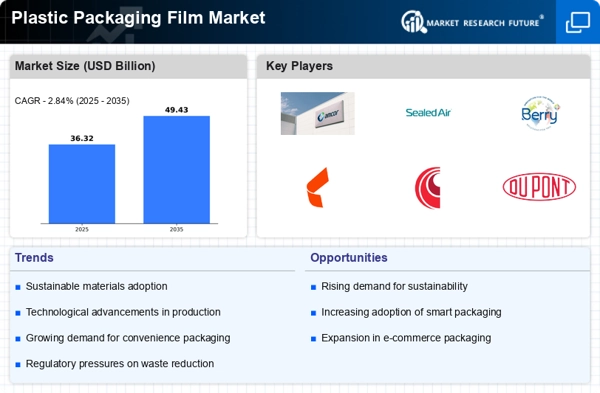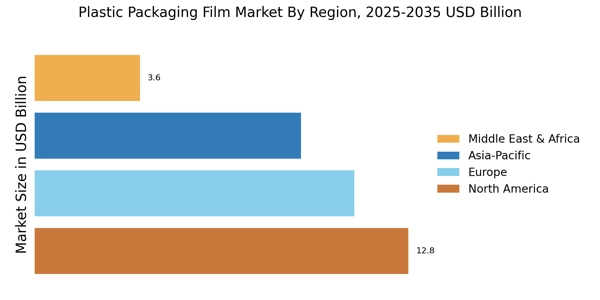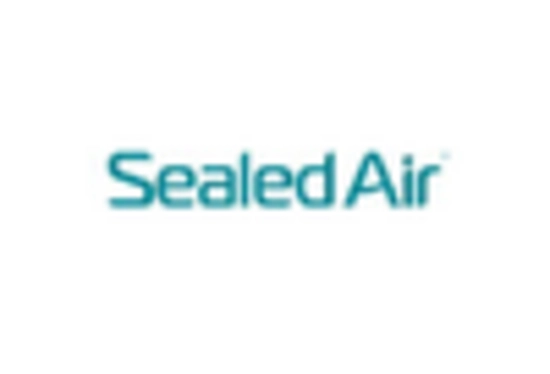Rising Demand for Convenience Foods
The increasing consumer preference for convenience foods is a notable driver in the Plastic Packaging Film Market. As lifestyles become busier, the demand for ready-to-eat meals and snacks continues to rise. This trend is reflected in market data, which indicates that the convenience food sector is projected to grow at a compound annual growth rate of approximately 4.5% over the next five years. Plastic packaging films play a crucial role in preserving the freshness and extending the shelf life of these products, thereby enhancing their appeal to consumers. Consequently, manufacturers are likely to invest in innovative packaging solutions that cater to this growing demand, further propelling the Plastic Packaging Film Market.
E-commerce Growth and Online Retailing
The rapid expansion of e-commerce and online retailing is significantly influencing the Plastic Packaging Film Market. As more consumers turn to online shopping, the need for effective packaging solutions that ensure product safety during transit becomes paramount. Market analysis suggests that the e-commerce sector is expected to witness a growth rate of around 15% annually, necessitating robust packaging materials. Plastic packaging films are favored for their lightweight and protective qualities, making them ideal for shipping a variety of products. This trend not only boosts the demand for plastic films but also encourages innovation in packaging designs tailored for e-commerce, thereby driving the Plastic Packaging Film Market.
Technological Innovations in Packaging
Technological innovations in packaging are driving advancements in the Plastic Packaging Film Market. The integration of smart packaging technologies, such as active and intelligent packaging, is gaining traction. These innovations enhance product shelf life and provide real-time information about product conditions. Market data suggests that the smart packaging segment is anticipated to grow at a rate of 7% annually. As manufacturers adopt these technologies, they are likely to improve the functionality and appeal of plastic packaging films. This trend not only meets consumer demands for enhanced product experiences but also positions the Plastic Packaging Film Market for sustained growth in the coming years.
Increased Focus on Food Safety and Hygiene
The heightened awareness regarding food safety and hygiene is a critical driver for the Plastic Packaging Film Market. Consumers are increasingly concerned about the quality and safety of their food products, leading to a demand for packaging solutions that ensure hygiene and prevent contamination. Data indicates that the food packaging segment is projected to grow by approximately 5% annually, with plastic films being a preferred choice due to their barrier properties and ability to maintain product integrity. This focus on safety not only influences consumer purchasing decisions but also compels manufacturers to adopt advanced packaging technologies, thereby fostering growth in the Plastic Packaging Film Market.
Sustainability and Eco-friendly Packaging Solutions
The growing emphasis on sustainability and eco-friendly packaging solutions is reshaping the Plastic Packaging Film Market. As consumers become more environmentally conscious, there is a rising demand for packaging materials that are recyclable or biodegradable. Market trends indicate that the eco-friendly packaging segment is expected to expand at a rate of 6% per year. This shift is prompting manufacturers to explore alternative materials and innovative designs that minimize environmental impact. Consequently, the Plastic Packaging Film Market is likely to witness a transformation as companies strive to meet consumer expectations for sustainable packaging, potentially leading to new product developments and market opportunities.


















Leave a Comment